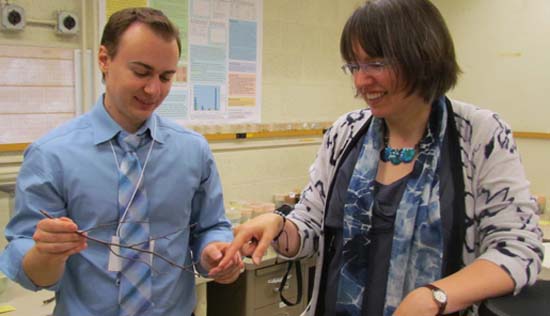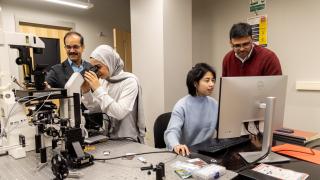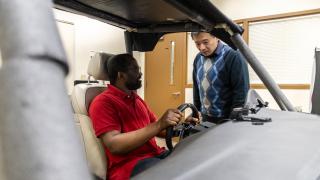
That includes prying food from their mate’s jaws. Though uncommon in humans, some spiders will do just that to get their fill.
And Yevhen Drobot can prove it. The University of Michigan-Dearborn senior investigated the Tetragnatha elongata species to determine how male spiders feed.
http://youtu.be/IornKcl8Xmk
His curiosity stems from the fact that adult male spiders don’t build webs, which means they can’t capture prey and feed themselves.
So Drobot and Anne Danielson-Francois, assistant professor of biology, scoured the Rouge River a couple of summers ago in search of the spiders.
“They’re actually quite tricky to find,” Danielson-Francois said. “I call them ‘masters of camouflage.’ You could be looking at a branch that has five of them and you won’t even see them.”
The best spot to collect the spiders, according to Drobot, were along tree branches that hung over the river.
Drobot and Danielson-Francois, along with a few other UM-Dearborn students, collected 275 spiders and took them back to the laboratory for staged mating trials.
Out of 165 trials, 43 male spiders attempted to steal food from their female mates. Fifteen of those attempts were successful.
The study is the first of its kind to reveal that male spiders can actively steal food from their mating partners, Drobot said.
“The first time we saw it, we didn’t really know why it happened,” he said. “It was really interesting.”
And what prompted many of the male spiders to steal their mate’s food wasn’t the treat itself, but rather the female’s size.
“When the male’s body size was close to the female’s body size, he was more likely to steal the food,” Danielson-Francois said. “If the female was much heavier than him, it was much more difficult to get the food.”
One would assume that male spiders have an easy decision to make – mate with smaller females so they can steal food. But, according to Drobot, male spiders prefer mating with larger females because they have greater reproductive success.
“This finding suggests that, in this species, males may have a tradeoff between acquiring food resources from a smaller female and achieving greater reproductive success from mating with a more fecund, larger female,” according to the research.
Drobot recently presented the findings as part of the College of Arts, Sciences, and Letters’ (CASL) Undergraduate Student Research Showcase. He was among dozens of CASL students who displayed their research on topics ranging from Socrates to chimpanzees.
“Our campus takes seriously the teacher-scholar model,” said CASL Dean Jerold Hale. “One important facet of that model is engaging our students in the research process.”
Hale commended CASL faculty, including Danielson-Francois, for their ability to “spark the curiosity of their students by involving them in research.”
“The result is really excellent work,” he said.
And as for Drobot, he plans to pursue a career in the medical field.
“He’s multitalented and his research skills will be invaluable in medical school,” Danielson-Francois said. “I cannot wait to see what he discovers next.”





